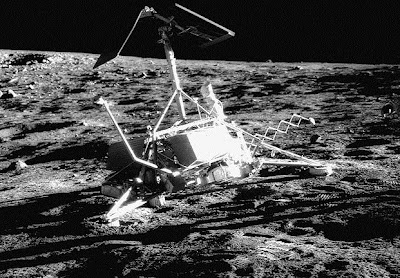Armed with my handy space maps, I am always on the lookout for Apollo Moon Trees, wherever I go. Virginia was no exception, and I found the tallest one I've seen yet!
Apollo 14 Command Module pilot Stuart Roosa, who remained in lunar orbit while his cohorts Alan Shepard and Ed Mitchell frolicked about Fra Mauro, took hundreds of redwood, sycamore, pine, fir and sweetgum tree seeds aboard the Kitty Hawk capsule in 1971, at the request of Forest Service employees. Upon return to Earth, the seeds were distributed to various communities, resulting in the "Moon Trees".
Can you think of a better place to plant a Moon Tree?
Most Moon Trees were planted as experimental controls, alongside normal seeds, though many decades later there is no visible difference. The majority were distributed as seedlings, and planted in 1976 for bicentennial celebrations, though the List of Moon Trees records plantings from as early as 1973 and as late as 1984.
A few traveled to foreign nations, and still others found their way to universities, NASA centers, national parks and monuments -- including the White House. To date, only one was ever deliberately removed – a New Orleans pine that was damaged during Hurricane Katrina.
My recent find was a beautiful sycamore at Booker Elementary School on Apollo Drive in Hampton, Virginia.
Hampton, VA Moon Tree
This particular tree is very special, and different from the others in that it was the result of a poetry contest held among the schoolchildren.
In 1976, then-6th grader Marjorie White (who is 52 now) wrote the winning poem called "A Tree Lives", which Booker has kept on their main office wall for many years, alongside a gold NASA plaque from when the tree was dedicated during the Bicentennial, and once again at the 30th anniversary in 2006.
The Winning Poem!
"A Tree Lives" by Marjorie White
(Click to see original in larger type!)
"A Tree Lives" by Marjorie White
(Click to see original in larger type!)
Despite knowing Roosa had hundreds of seeds, only 90 are listed officially by NASA – and a mere 44 have been photographed by the Waymarkers Moon Tree Group. Sadly, they were not tracked efficiently. Like the Goodwill Moon Rocks, the 1970s handlers were casual about what would one day become a part of world heritage.
Pulling togehter many resources over the years, I have catalogued directions and coordinates to 83 Apollo Moon Trees, which can be found (along with outdoor scaled Solar Systems) on my Pillownaut Nature Walks Map.
If you know the location of any seeds, or where they were planted, curators at the National Space Science Data Center would love to hear from you. Email NASA if you find one!



























